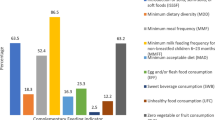Abstract
Objectives To ensure proper nutrition and optimal health outcomes, it is critical that infants are exclusively breastfed (0–6 months) and then receive adequate feeding from 6–23 months (breastfeeding and frequent feedings of complementary foods). Despite policies and guidelines on adequate feeding in Myanmar, past research has found low rates of adequately fed infants 0–11 months and little is known about the adequacy of feeding practices for children 12–23 months. The aim of this study is to understand the feeding practices of children aged 0–24 months in Myanmar and maternal characteristics associated with adequate feeding practices. Methods This study examines the rates of adequately fed infants and young children (0–23 months) in hard-to-reach townships in Myanmar from a cross-sectional, multistage cluster survey. Survey data on nutritional practices were collected from 489 mothers. Data were analyzed using multivariate regressions. Results We found that 41.8 % of infants under 6 months were exclusively breastfed, 63.2 % of those aged 6–11 months were adequately fed, and 10.3 % of 12–23 month-olds were adequately fed. In multivariate regressions we found that antenatal care visits [1–4 visits, AOR = 6.59 (p < 0.01) and >4 visits, AOR = 6.63 (p < 0.05)] was associated with exclusive breastfeeding for under 6 month old infants. Having >4 antenatal care visits [AOR = 9.97 (p < 0.05)] was associated with adequate feeding for 6–11 months old infants. Conclusions Future nutritional interventions and policies should focus on improving messaging about adequate feeding practices, especially for 12–23 months olds.
Similar content being viewed by others
References
Shekar, M. (2006). Repositioning nutrition as central to development: A strategy for large scale action. Washingotn, DC: The World Bank.
Walker, S. P., Wachs, T. D., Gardner, J. M., et al. (2007). Child development: risk factors for adverse outcomes in developing countries. The Lancet, 369(9556), 145–157.
Chaparro, C., Oot, L., & Sethuraman, K. (2014). Overview of the nutrition situation in seven countries in Southeast Asia. Washington, DC: FHI 360/FANTA2014.
UNICEF (2011). Myanmar multiple indicator cluster survey 2009–2010.
World Health Organization. (2008). Indicators for assessing infant and young child feeding practices. France: WHO Library Cataloguing-in-Publication Data.
Dibley, M. J., Senarath, U., & Agho, K. E. (2010). Infant and young child feeding indicators across nine East and Southeast Asian countries: An analysis of National Survey Data 2000–2005. Public Health Nutrition, 13(9), 1296–1303. doi:10.1017/S1368980010000844.
Taw, P. N. (2009). Country report on the 2007 fertility and reproductive health survey. Myanmar: Ministry of Immigration and Population, Department of Population and UNFPA.
Filmer, D., & Pritchett, L. H. (2001). Estimating wealth effects without expenditure data-or tears: An application to educational enrollments in states of India. Demography, 38(1), 115–132.
StataCorp. (2011). Stata Statistical Software: Release 12. College Station, TX: StataCorp LP.
Mamiro, P. S., Kolsteren, P., Roberfroid, D., et al. (2005). Feeding practices and factors contributing to wasting, stunting, and iron-deficiency anaemia among 3–23-month old children in Kilosa district, rural Tanzania. Journal of Health, Population and Nutrition, 23(3), 222–230.
Thet, M. M., Khaing, E. E., Diamond-Smith, N., Sudhinaraset, M., Oo, S., & Aung, T. (2016). Barriers to exclusive breastfeeding in the Ayeyarwaddy region in Myanmar: Qualitative findings from mothers, grandmothers, and husbands. Appetite, 1(96), 62–69.
Diamond-Smith, N., & Sudhinaraset, M. (2015). Drivers of facility deliveries in Africa and Asia: regional analyses using the demographic and health surveys. Reproductive Health, 12(6), 1–14.
Kimani-Murage, E. W., Madise, N. J., Fotso, J.-C., et al. (2011). Patterns and determinants of breastfeeding and complementary feeding practices in urban informal settlements, Nairobi Kenya. BMC Public Health, 11(396), 1.
Shroff, M., Griffiths, P., Adair, L., et al. (2009). Maternal autonomy is inversely related to child stunting in Andhra Pradesh, India. Maternal and Child Nutrition, 5(1), 64–74.
World Health Organization. (2003). Global stategy for infant and young child feeding. New York: UNICEF.
Chit, T. M., Kyi, H., & Thwin, A. (2003). Mothers’ beliefs and attitudes towards child weight, child feeding and related practices in Myanmar. Nutrition and Health, 17(3), 231–254. doi:10.1177/026010600301700306.
Thin Thin, D. (2003). Beliefs attitudes and practices of mother regarding exclusive breast feeding in Myanmar. Melbourne: La Trobe University.
Dewey, K. G., Cohen, R. J., & Rollins, N. C. (2004). Feeding of nonbreastfed children 6–24 months of age in developing countries. Food and Nutrition Bulletin, 25(4), 377–402.
Black, R. E., Allen, L. H., Bhutta, Z. A., et al. (2008). Maternal and child undernutrition: global and regional exposures and health consequences. The Lancet, 371(9608), 243–260.
Acknowledgments
The authors would like to thank Dr. Tin Aung (Director, Strategic Information Department), Dr. Nang Mo Hom (Research Unit/Strategic Information Department), U Zaw Win (Research Unit/Strategic Information Department) and staff from PSI Myanmar for providing the required support for the study. Our thanks will also go to the 3 Millennium Development Goal Fund (3MDG) for financial support to conduct the study.
Author information
Authors and Affiliations
Corresponding author
Ethics declarations
Conflict of interest
The authors state that we have no conflicts of interest.
Rights and permissions
About this article
Cite this article
Thet, M.M., Richards, LM., Sudhinaraset, M. et al. Assessing Rates of Inadequate Feeding Practices Among Children 12–24 months: Results from a Cross-Sectional Survey in Myanmar. Matern Child Health J 20, 1688–1695 (2016). https://doi.org/10.1007/s10995-016-1968-2
Published:
Issue Date:
DOI: https://doi.org/10.1007/s10995-016-1968-2




